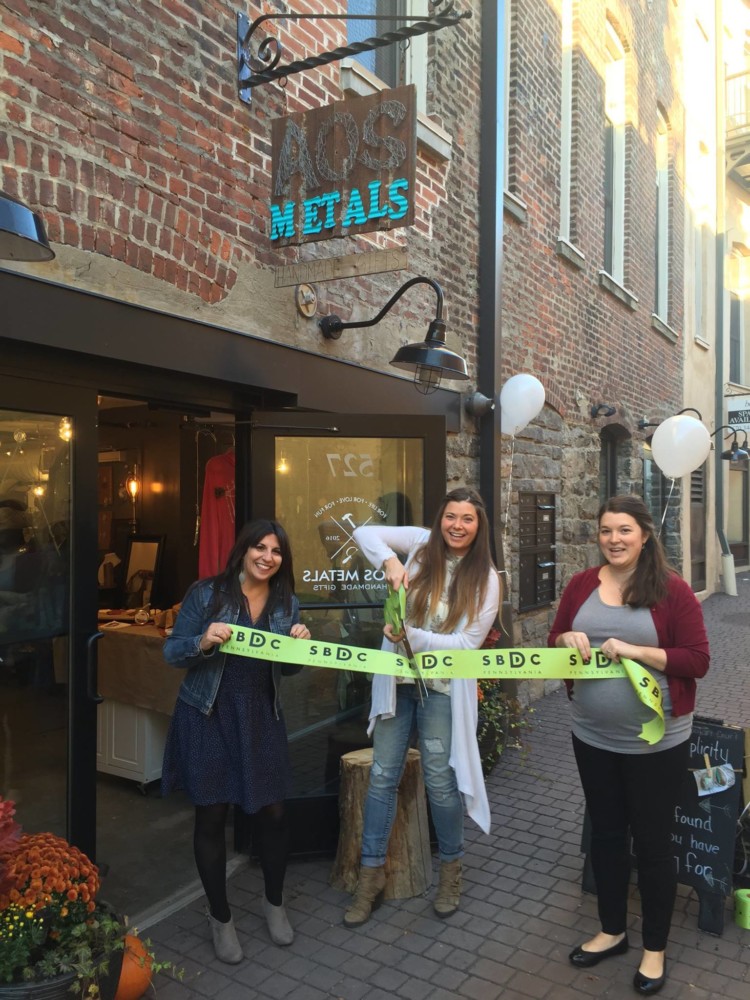By Kyle Wind
The Times-Tribune, Scranton, Pa.
WWR Article Summary (tl;dr) Before jewelry maker Kari Johnson made the leap into entrepreneurship, she took classes from the Small Business Development Center at the University of Scranton. Through that experience she became one of the first two recipients of a new microloan program for women.
The Times-Tribune, Scranton, Pa.
Not long ago, Kari Johnson was an artist, not a businesswoman.
That changed more quickly than the 36-year-old could have imagined when her return to Northeast Pennsylvania after more than a decade — initially intended to be temporary, likely on the way to New York — culminated with her opening AOS Metals in downtown Scranton.
In the span of months, the Tunkhannock native transitioned from selling handcrafted metal jewelry online while she lived in Jackson, Wyoming, to opening a bricks-and-mortar store on Bogart Court as one of several tenants working to solidify a downtown arts district.
Before she took the leap, Johnson took classes from the Small Business Development Center at the University of Scranton, won six months of free rent in the Kickstart Art Challenge and became one of the first two recipients of a new microloan program for women.
“I can’t even wrap my head around it,” she said. “All of a sudden, I was a small business owner.”
The Kickstart Art Challenge, sponsored by Renaissance at 500, allowed artists and artisans to showcase their wares in pop-up shops in boutique spaces and compete for chances to get six free months of rent.
Johnson heard about the contest through the SBDC and described feeling growing confidence as she put together an application that included her store concept and financial projections.
When Johnson won a space, however, she still had a problem: she needed startup money to make it work.
Most traditional lenders are uneasy about providing loans to a new business that doesn’t have valuable equipment that can be used as collateral if it doesn’t work out.
“When I did talk to lenders, they said, ‘You don’t have any big equipment,'” Johnson said. “I work with hand tools. I make everything from scratch.”
Johnson’s circumstances made her a perfect candidate for the Women in Philanthropy program’s micro-lending program, designed to help female entrepreneurs get their ideas off the ground or expand existing businesses, said Laura Ducceschi, chief executive officer of the Scranton Area Community Foundation.
AOS Metals and Tiddlywinks Children’s Boutique became the first two businesses to collect loans — of $5,000 and $10,000 respectively — after going through a process that includes mentorship, training and submitting business plans to a committee for vetting.
“There was no holding back,” Johnson recalled. “The people on that board were like, ‘These financials are way off for this reason. The business plan says this? Are you kidding me? No, she’s not even thinking.’ … It was extreme, and it was intense. But in the long run, it made me a better person.”
Since the foundation announced the program that provides $1,000 to $10,000 loans, Peoples Security Bank agreed to administer the loans, pledging up to $300,000 in capital over three years to support the program.
The loans have a payback period of up to four years and carry a 6 percent interest rate, but the bank offered to put the money into a savings account and give participants the interest back after paying it off.
Jeff Solimine, a vice president/mortgage originator, said the operation wanted to help the community and saw a chance to ignite a part of the area’s economy that isn’t active.
“Every time you help somebody and see somebody have a dream they didn’t think was possible one day be possible, it should make everybody involved feel pretty good,” he said.
Johnson said the micro-loan helped her stock her store, add variety by bringing in works from other artists, pay some bills and deal with other surprise expenses.
Things have been going well, particularly leading up to Christmas and on First Fridays, with her stacking rings and simple necklaces being among the best-sellers, she said.
“I’ve got college kids that love to come in and buy the $20, $30 necklaces that are simple and classic,” Johnson said. “Then I’ve got the older group of professional women who come in every time and are adding the simple pieces or some of the more complicated pieces … I think they just really like the fact that it’s seriously made by hand. Everything starts as a piece of wire or a sheet of metal.”














































































































































































































































































































































































